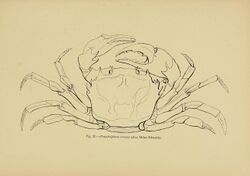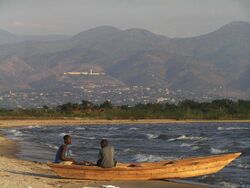Biology:Platythelphusa
| Platythelphusa | |
|---|---|

| |
| Platythelphusa armata | |
| Scientific classification | |
| Kingdom: | |
| Phylum: | |
| Subphylum: | |
| Class: | |
| Order: | |
| Infraorder: | |
| Family: | |
| Genus: | Platythelphusa A. Milne-Edwards, 1887
|
| Type species | |
| Platythelphusa armata A. Milne-Edwards, 1887 | |
| Species | |
| |
Platythelphusa is a genus of freshwater crabs endemic to Lake Tanganyika. It has been placed in a number of families, including a monotypic family, Platythelphusidae, as well as Potamidae and its current position in the Potamonautidae, and has also been treated as a subgenus of Potamonautes. It forms a monophyletic group, possibly nested within the genus Potamonautes, which would therefore be paraphyletic.[1] The genus is the only evolutionary radiation of crabs to have occurred in a freshwater lake, and it occurred recently, probably since the Pliocene.[2] This parallels the better known radiation of cichlid fishes in Lake Tanganyika.[3] Only one other species of freshwater crab is found in Lake Tanganyika, Potamonautes platynotus.[2]
Taxonomic history
The first freshwater crab to be described from Lake Tanganyika, by Alphonse Milne-Edwards in 1887, was considered so distinct from the other crabs known up to that time that it was placed in a new genus, as Platythelphusa armata. Twelve years later, a second species was described by W. A. Cunnington, leader of the third Tanganyika Expedition, and was also placed in a separate genus, as Limnothelphusa maculata. The same author later described a third species, Platythelphusa conculata, and eventually realised that all three belonged to the same genus, reducing Limnothelphusa to a taxonomic synonym.[4]
In 1952, Capart did not recognise the species P. conculcata, but added four new species, P. denticulata, P. echinata, P. polita and P. tuberculata. Since that time, P. conculcata has been restored, and two new species have been described, P. immaculata and P. praelongata.[5]
Distribution
All nine species live in relatively shallow waters around the edge of Lake Tanganyika. While four countries border Lake Tanganyika (Burundi, Democratic Republic of the Congo, Tanzania and Zambia), only two species have been found in all four countries, P. armata and P. conculcata. One species, P. polita, has been found in all except Zambia; two (P. echinata and P. tuberculata) have been found in Burundi and Tanzania; one has been found in Tanzania and Zambia (P. maculata); one is only known from Zambia (P. praelongata) and two have only been seen in Tanzania (P. denticulata and P. immaculata). However, many of the species are poorly known, and their true distributions may be wider than is currently known.[2]
Species
Platythelphusa armata
As the largest species in the genus (up to 6 cm or 2.4 in in carapace width), Platythelphusa armata is subject to small-scale fishery.[5][6] Adults live at depths of 5–30 metres (16–98 ft), while juveniles live at depths of 1–10 metres (3.3–32.8 ft), and often inhabit discarded Neothauma tanganyicense shells. The species is listed as Least Concern by the IUCN.[7]
Platythelphusa conculcata
Platythelphusa conculcata is found at depths of 20–60 metres (66–197 ft), and is listed as Least Concern by the IUCN.[8]
Platythelphusa denticulata
Platythelphusa denticulata is known from few sites, all in Tanzania. Though it may have a low population, there is no evidence of a decline and it is listed as Least Concern by the IUCN.[9]
Platythelphusa echinata
Platythelphusa echinata is found at depths of 5–30 metres (16–98 ft) on the Tanzanian and Burundian shores of Lake Tanganyika. It lives where the substrate is rocky or sandy, and occasionally uses old Neothauma shells.[10]
Platythelphusa immaculata
Platythelphusa immaculata is known from only 25 specimens, but is listed as Least Concern, because there are no apparent threats to its survival.[11]
Platythelphusa maculata
Platythelphusa maculata lives on sand and rocks, and occasionally in Neothauma shells, at depths of 1–60 metres (3.3–196.9 ft), and is listed as Least Concern.[12]
Platythelphusa polita
Platythelphusa polita lives on sand and rocks, and occasionally in Neothauma shells, at depths of 5–60 metres (16–197 ft), and is listed as Least Concern.[13]
Platythelphusa praelongata
Platythelphusa praelongata lives at the greatest depth of any Platythelphusa species, the single known specimen having been collected at 40–80 metres (130–260 ft), around Mbita Island, and is listed as Data Deficient.[14]
Platythelphusa tuberculata
Platythelphusa tuberculata has longer legs than the other species, and lives at the northern end of Lake Tanganyika, on muddy substrates. It has been found in the stomachs of fish including Chrysichthys brachynema and Bathybagrus stappersii (formerly Chrysichthys stappersii).[15]
References
- ↑ Neil Cumberlidge, Richard M. von Sternberg & Savel R. Daniels (2008). "A revision of the higher taxonomy of the Afrotropical freshwater crabs (Decapoda: Brachyura) with a discussion of their biogeography". Biological Journal of the Linnean Society 93 (2): 399–413. doi:10.1111/j.1095-8312.2007.00929.x.
- ↑ 2.0 2.1 2.2 Saskia A. E. Marijnissen; Ellinor Michel; Savel R. Daniels; Dirk Erpenbeck; Steph B. J. Menken; Frederick R. Schram (2006). "Molecular evidence for recent divergence of Lake Tanganyika endemic crabs (Decapoda: Platythelphusidae)". Molecular Phylogenetics and Evolution 40 (2): 628–634. doi:10.1016/j.ympev.2006.03.025. PMID 16647274.
- ↑ Walter Salzburger; Tanja Mack; Erik Verheyen; Axel Meyer (2005). "Out of Tanganyika: Genesis, explosive speciation, key-innovations and phylogeography of the haplochromine cichlid fishes". BMC Evolutionary Biology 5 (1): 17. doi:10.1186/1471-2148-5-17. PMID 15723698.
- ↑ R. von Sternberg (1999). "A cladistic analysis of Platythelphusa A. Milne-Edwards, 1887, from Lake Tanganyika, East Africa (Decapoda: Potamoidea: Platythelphusidae) with comments on the phylogenetic position of the group". Journal of Natural History 33 (4): 493–511. doi:10.1080/002229399300218.
- ↑ 5.0 5.1 Saskia A. E. Marijnissen; Frederick R. Schram; Neil Cumberlidge; Ellinor Michel (2004). "Two new species of Platythelphusa A. Milne-Edwards, 1887 (Decapoda, Potamoidea, Platythelphusidae) and comments on the taxonomic position of P. denticulata Capart, 1952 from Lake Tanganyika, East Africa". Crustaceana 77 (5): 512–532. doi:10.1163/1568540041717984.
- ↑ N. Cumberlidge; R. von Sternberg; I. R. Bills; H. Martin (1999). "A revision of the genus Platythelphusa A. Milne-Edwards, 1887 from Lake Tanganyika, East Africa (Decapoda: Potamoidea: Platythelphusidae)". Journal of Natural History 33 (10): 1487–1512. doi:10.1080/002229399299860.
- ↑ N. Cumberlidge & S. A. E. Marijnissen (2008). "Platythelphusa armata". IUCN Red List of Threatened Species 2008: e.T44196A10861476. doi:10.2305/IUCN.UK.2008.RLTS.T44196A10861476.en. https://www.iucnredlist.org/species/44196/10861476.
- ↑ N. Cumberlidge & S. A. E. Marijnissen (2008). "Platythelphusa conculcata". IUCN Red List of Threatened Species 2008: e.T44197A10861759. doi:10.2305/IUCN.UK.2008.RLTS.T44197A10861759.en. https://www.iucnredlist.org/species/44197/10861759.
- ↑ N. Cumberlidge & S. A. E. Marijnissen (2008). "Platythelphusa denticulata". IUCN Red List of Threatened Species 2008: e.T44552A10918760. doi:10.2305/IUCN.UK.2008.RLTS.T44552A10918760.en. https://www.iucnredlist.org/species/44552/10918760.
- ↑ N. Cumberlidge & S. A. E. Marijnissen (2008). "Platythelphusa echinata". IUCN Red List of Threatened Species 2008: e.T44198A10862040. doi:10.2305/IUCN.UK.2008.RLTS.T44198A10862040.en. https://www.iucnredlist.org/species/44198/10862040.
- ↑ N. Cumberlidge & S. A. E. Marijnissen (2008). "Platythelphusa immaculata". IUCN Red List of Threatened Species 2008: e.T44553A10918991. doi:10.2305/IUCN.UK.2008.RLTS.T44553A10918991.en. https://www.iucnredlist.org/species/44553/10918991.
- ↑ N. Cumberlidge & S. A. E. Marijnissen (2008). "Platythelphusa maculata". IUCN Red List of Threatened Species 2008: e.T44518A10910802. doi:10.2305/IUCN.UK.2008.RLTS.T44518A10910802.en. https://www.iucnredlist.org/species/44518/10910802.
- ↑ N. Cumberlidge & S. A. E. Marijnissen (2008). "Platythelphusa polita". IUCN Red List of Threatened Species 2008: e.T44519A10911213. doi:10.2305/IUCN.UK.2008.RLTS.T44519A10911213.en. https://www.iucnredlist.org/species/44519/10911213.
- ↑ N. Cumberlidge & S. A. E. Marijnissen (2008). "Platythelphusa praelongata". IUCN Red List of Threatened Species 2008: e.T44554A10919219. doi:10.2305/IUCN.UK.2008.RLTS.T44554A10919219.en. https://www.iucnredlist.org/species/44554/10919219.
- ↑ N. Cumberlidge & S. A. E. Marijnissen (2008). "Platythelphusa tuberculata". IUCN Red List of Threatened Species 2008: e.T44199A10862353. doi:10.2305/IUCN.UK.2008.RLTS.T44199A10862353.en. https://www.iucnredlist.org/species/44199/10862353.
Wikidata ☰ Q2594196 entry
 |


